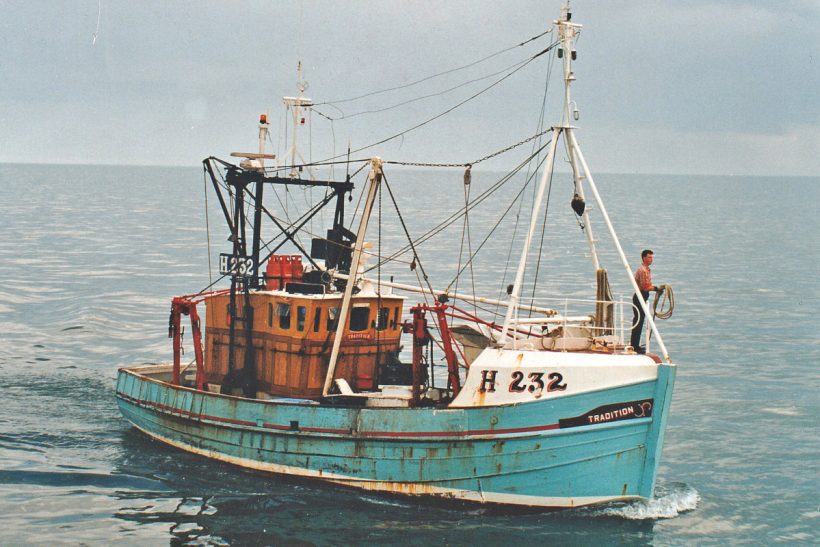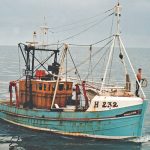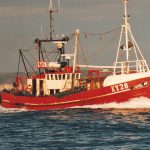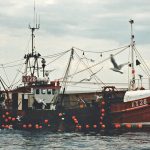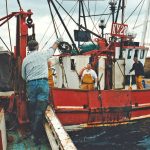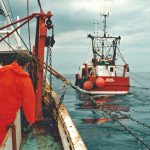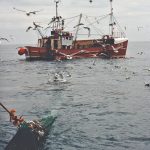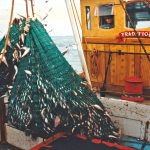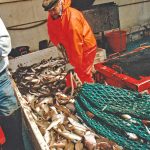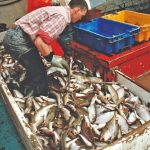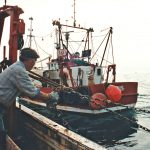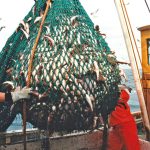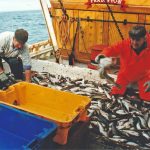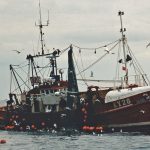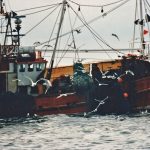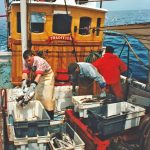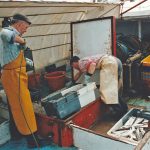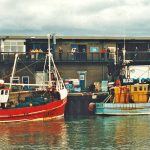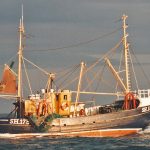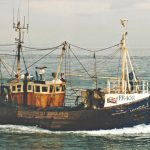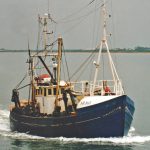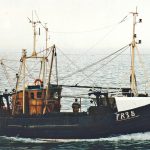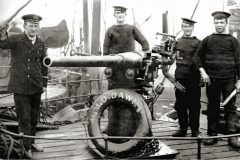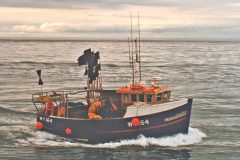In the third instalment of this occasional series, David Linkie looks back on fishing trips – some of them in fisheries now sadly consigned to history – that he has experienced over the past 30-plus years
Cod lying on hard ground off the Yorkshire coast sustained generations of fishermen and their families. Daily supplies of prime-quality cod caught by a variety of fishing methods, including long-lining, netting and trawling, met consistently high demand from fish and chip shops in the South Yorkshire industrial conurbations of Sheffield, Barnsley, Doncaster and Rotherham, as well as many smaller towns closer to the coast.
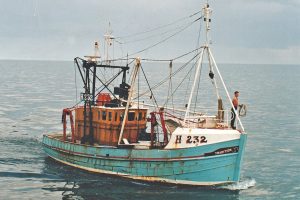
The Bridlington pair-team Tradition…
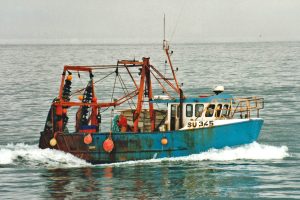
Telesis
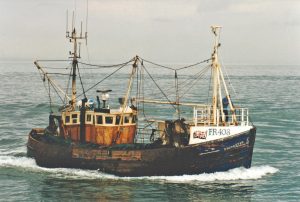
Enchanter
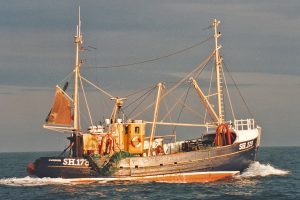
Crusader running off to pair with Eagernoon.
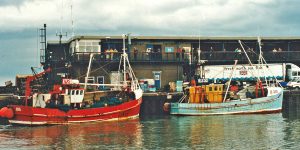
Ubique and Tradition landing at Bridlington.
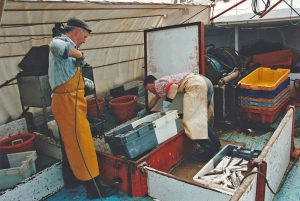
Lowering boxes down to the fishroom.
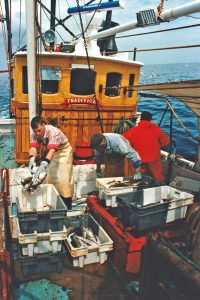
Selecting and boxing codling on Tradition.
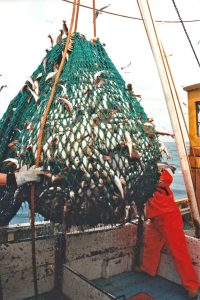
Taking a good lift aboard Tradition
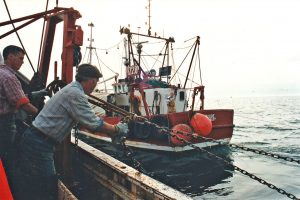
Preparing to pass the port end over to Ubique.
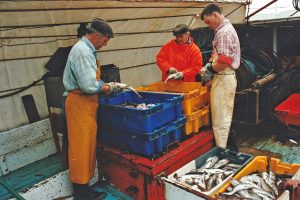
Gutting the catch on Tradition.

Ubique towing.
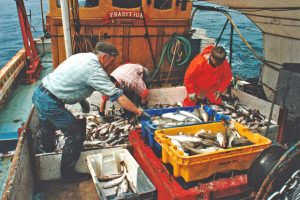
Selecting fish into boxes from the deck pond.
For many coble and keel boat fishermen at Staithes, Whitby, Scarborough, Filey, Flamborough and Bridlington, cod was an intrinsic part of well-established seasonal fishing patterns, as well as their lives. In less than a generation, this tradition – together with several others – has been consigned to history, as the restrictions on fishing opportunities emanating from Brussels escalated with drastic effect.
This first instalment of a three-part feature, compiled from trips made over 25 years ago, focuses on a day with skipper Dennis Jewitt and the crew of Tradition H 232, pair-trawling with Ubique KY 28 off Flamborough Head, in September 1995.
As Tradition’s Flamborough crew of John Stephenson, John Scotter and Richard Stephenson cast off the ropes at 4am on a Sunday morning, skipper Dennis Jewitt set a northeast course to clear Flamborough Head on a two-hour steam to grounds known locally as the Back of the Ridge – an extension of the hard ground running southeast from Filey Brigg.
Fresh sea winds had prevailed for several weeks, when – as usual in these conditions – catch rates had dropped. Now the wind was off the land again, so better results were hoped for. This positive thought was offset by a mechanical failure at the local ice plant, which meant that plans were changed to make it a short day, in order to land that night.
Cod continued to be the main species caught throughout the year by keel boats fishing from the trawling-orientated harbours of Whitby, Scarborough and Bridlington. While sole could appear from time to time, meagre quotas prevented this species from realising its potential. Fishing in the early summer could be fairly light, before a seasonal run of whiting showed up on the grounds to boost catches.
The arrival of the herring shoals on the 12-mile banks off Whitby and Scarborough towards the end of the summer could give a better showing of cod. Good catches usually appeared in the last three months of the year, when cod moved inshore to the unique North Flamborough Head grounds that – given the right conditions and years of hard-earned local knowledge – could yield prolific runs of green.
There had been a slightly better showing on some of the inshore grounds over the previous couple of years. This was thought to be an encouraging sign that whitefish stocks were being fished at a sustainable level, allowing them to increase a little. Catches in the first half of 1995 again revealed a growing number of codling just below the minimum size. This was an indication of another good class of fish coming through, and provided encouragement for the following year.
Acutely aware of the importance of promoting stock growth, Tradition and Ubique had been among the first east coast boats to fit 90mm square mesh escape panels in their pair-trawls a few years earlier, both voluntarily and as part of Seafish trials.
These trials, conducted a couple of years previously, had shown significant potential, and skipper Dennis Jewitt questioned why the government appeared to have lost interest in the initiative. Despite the promising trials, it was not supporting more research, or further development of square mesh panels, at a time when the fleet was continually being cut on conservation grounds, and the good year classes of fish appearing on the grounds were being endangered.
While quotas were just about viable at the time of this trip, the biggest stumbling block for the east coast fleet was depressed prices on Hull fishmarket, to which most Brid boats consigned their catches. Earlier in 1995, best day-old sprags had sold for as little as £3.50 per stone (approximately 60p per kg). These weak prices were attributed to the continual high levels of imported fish.
Although prices had recovered somewhat by September of 1995, when this trip took place, cod seldom brought more than £9/st, while small codling were making £5.50, haddock £6.50, best lemons £16 and whiting £1.80 per stone.
Tradition and Ubique formed one of two pair teams that fished year-round from Bridlington at the time of this trip, the other being Mick Sayer’s Onward Star and Enchanter, skippered by Clive Kingston. Roy Leng’s Crusader had recently teamed up with Derek Tye’s Eagernoon. The rest of the local fleet – including Ocean Reward, Telesis, St Andrew, Radiant Trust, Pamela S, Optimistic, Josie B, Regal Star and Katie Jane – single-boated.
When the two boats reached the selected waypoint, Ubique came alongside Tradition to pull her pair trawl into the water, ready for shooting away in 30 fathoms.
For nearly a decade, Tradition and Ubique had successfully fished a Swan Net pair trawl. This choice of net was the result of skipper Dennis Jewitt meeting Ireland’s most famous net designer, Albert Swan, at the FISHING ’86 exhibition in Glasgow, when he enquired about a trawl to fish for codling on very rough ‘catchy’ ground.
At the time, Tradition and Ubique were using the popular Danish ‘balloon’ trawl, but while this performed well offside, the pair found themselves being outfished by trawlers during the winter in murky waters on the Flamborough Head grounds.
Albert Swan then designed a Seastar long-wing trawl which was to prove equally effective throughout the year on a wide range of grounds, and prevented the vessels having to change back to single-trawling in the winter months, with the associated extra expense and inconvenience this incurred.
The Seastar trawl is a four-panel net with a deep wing cover and long wing top, cut to allow the heading to rise. Featuring a heavy rig, the nets have 470 x 6in meshes in the round, and are rigged with 33 x 11in-diameter floats on the heading to give a headline height of 3.5 fathoms.
Ubique’s net had 112ft of heavy ground rig, tapering from 16in to 12in discs, while the net worked on the 45ft Tradition was rigged with 100ft of similar-sized ground gear. Both boats used 22ft of extension chains on the lower wings, which were cut short.
Twenty fathoms of chain sweeps, followed by 100 fathoms of 3in warp and 200 fathoms of 2in warp – giving some 80 fathoms of warp on the seabed – were run off the winch drums and chained up to the towing leg on the transom.
The boats then settled down 0.16 nautical miles apart to tow north into the flood tide, at the start of what was expected to be a five-hour drag, passing close to several known fasteners. These were clearly shown on the RS 2500 colour chart plotter, which was interfaced to an RS 5310 GPS navigator.
Mike ‘Pip’ Sayer’s Onward Star, which at the time was partnered by Phil Collin’s St Andrew, while Enchanter was on the slip at Grimsby for repairs, had shot one mile to the west, while Crusader and Eagernoon were towing along a parallel line to the northeast. Single trawlers were mostly working further inshore.
The JRC 216 colour sounder showed the occasional marking of feed and fish tight to rather stony bottom. This caused the gear to snag from time to time, but – by manoeuvring the boats and increasing the revs from the usual 1,300rpm towing speed – the tow was continued.
As the tide eased and the first of the ebb started to come through, the pair team turned round on the gear and continued the tow south-southeast, heading for a particularly hard piece of ground containing several known fasteners, but which could usually be relied on to yield the odd sprag or two.
After bouncing over several fasteners late in the tow, the shout came to heave up after five and a half hours. The warp was released from the snatch block on the aft gallows, and John Stephenson manned the low-pressure Norwinch – which had given 22 years of sterling service – as the warp cracked onto the drums. While Ubique came alongside to pick up her sweeps and haul the wing-ends to the gallows, skipper Dennis Jewitt manoeuvred Tradition ready to take the first lift of fish out of the codend.
As the bag was pulled across to Tradition, it revealed a slack double lift. When John Scotter released the codend from the first lift, some 10 kit of fish fell into the deck pond, consisting of a mixture of A4 and A5 sprags and a smaller run of codling below the minimum landing size, plus the occasional whiting.
Ubique took the second lift aboard, with Tradition’s crew hoping that it would contain a higher proportion of larger fish, as the smaller weaker fish tend to travel further down the extension piece.
Given that it was going to be a short trip, the lads were not too unhappy about the size of the first haul, although they wouldn’t have wanted it to be any less. Crusader and Eagernoon had a similar catch, while Pip Sayer reported a kit or two more from a similar run of fish just to the north.
With little time to steam to other grounds, the gear was released from the gallows again and the southerly tow got underway over a piece of ground known locally as ‘Crunchie’. The reason behind this became immediately apparent as gear continually hung up at the start of the tow, but the skippers managed to keep the tow going.
After gutting the catch, Tradition’s crew put four kit of sprags, three of codling and one of whiting down into the hold, before taking off their boots for a first-class lunch of roast beef and Yorkshires.
The second and final tow of the day, which finished up heading west towards Flamborough Head, progressed uneventfully and lasted another five hours.
On hauling, the bag surfaced to reveal a kit or two more bulk than the first tow. There was also a slightly higher proportion of sprags, and a couple of monks. The decks were quickly cleared while running south under the Flamborough cliffs, returning to Bridlington 16 hours after sailing.
Tradition and Ubique together landed just under 20 kits of quality fish through Bridlington Trawlers Ltd, which were consigned for sale on the Monday market at Hull. The landing illustrated that, with experience and perseverance, there was still a living to be made on traditional inshore grounds, given a fair share of luck – and a change towards informed and sensible government legislation.
The scale of the change that actually transpired in the next few years was difficult to imagine at the time of this trip. As quotas continued to be cut year on year, to the point of being completely unviable, the Bridlington trawler fleet, together with those at Scarborough and Whitby, followed a similarly rapid downward spiral. Before the millennium, whitefish landings at Bridlington were virtually non-existent.
Within two years of this trip, Tradition was rigged for offshore crabbing, while Ubique was sold to Port Seaton, as another strand of balance was removed.
A combination of perseverance, commitment and determination to continue earning an income from fishing saw a number of former trawlers, including Tradition, Onward Star and Ocean Reward, converted for offshore potting. Twenty years later, these boats are among the modern fleet of crabbers that have transformed Bridlington into the UK’s leading static-gear shellfish port.
Second Tradition
The late Flamborough skipper Dennis Jewitt started out from Bridlington aboard line boats fishing for cod, before having the Yorkshire coble Tradition built by the Whitehill yard in 1969.
Dennis Jewitt worked this 36ft coble, which featured a short foredeck and cuddy, from the North Landing at Flamborough, lining for cod and dogfish and crabbing.
In 1973, Tradition was sold to Whitby, when Dennis Jewitt, in partnership with his brother Brian and brother-in-law John Stephenson, decided to order a 45ft keel boat from Robson of South Shields. Built by Maurice Brown and fitted with a 175hp Volvo Penta engine, the new Tradition H 232 was intended primarily for lining, with a trawl winch and gallows being fitted only as a £7,000 last-minute decision.
She did well at first, lining for dogfish and breaking the Grimsby landings record. However, as prices started to drop and the shoals became scarcer, skipper Dennis Jewitt and his crew began to develop other fisheries. They successfully engaged in the seasonal sprat fishery, until those shoals also disappeared and, while they had been potting, greater emphasis was placed on trawling.
Teaming up with his brother-in-law Alwyn Emmerson and the Danish-built 54ft Industry H 443, Dennis Jewitt helped to develop pair-trawling at Bridlington at the same time as its popularity was growing at Grimsby.
Tradition was re-engined in the 1980s with a 300hp Volvo unit. Her pair-trawling partner, the 52ft Ubique KY 28, was built by James N Miller & Sons at St Monans in 1974 for Bridlington skipper George Edmond, in partnership with Bridlington Trawlers Ltd.
Skippered today by Richard Stephenson, Tradition has now worked pots from Bridlington for over 20 years.



